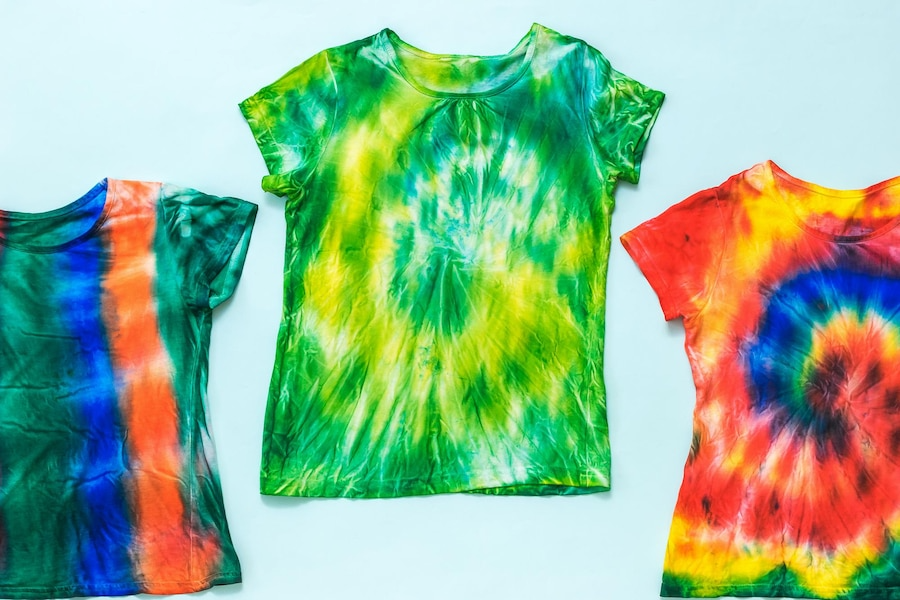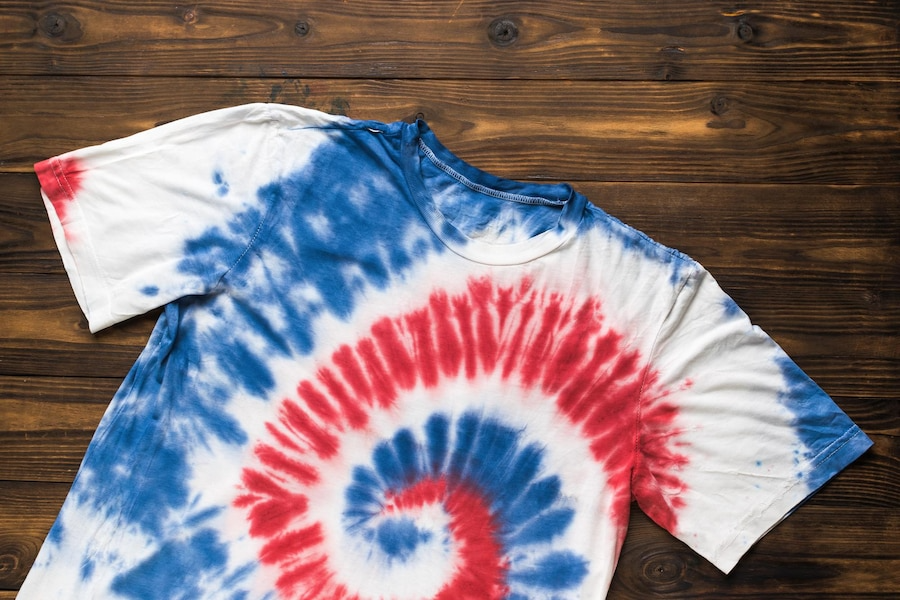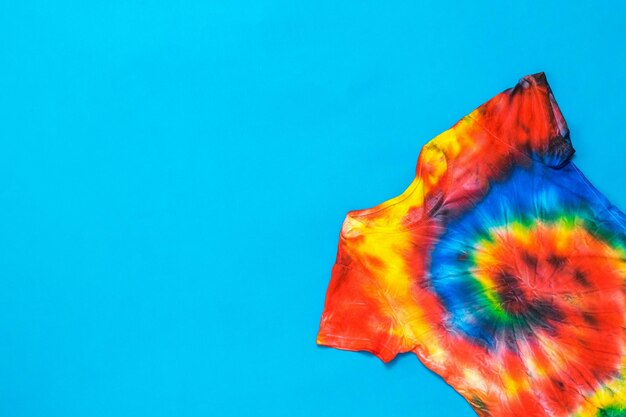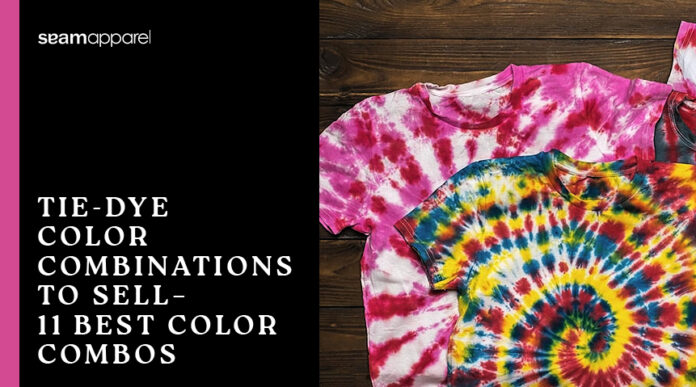If your attire is getting a little drab, pull out your tie-dye supplies and add some tie-dye colors to make it vibrant. You can mix more than one fun tie-dye color combo and pattern, contrasting what you may recall from arts and crafts at summer camp. Before getting began, you only need to study the greatest tie-dye color combinations!
One of the best things about tie dying is that you can make anything, whether you’re a novice or an experienced pro. It is astonishing how many things you can make using the best tie dye color combinations in swirl patterns to unusual pairings in one-of-a-kind designs.
The best tie dye color combinations consist of two or more main colors and steer clear of opposing complementary hues. One brilliant hue is used in various inventive patterns, such as spirals or starbursts, to create the simplest tie-dye designs. Tie-dye patterns in many colors are used for more t-shirt design placement guides.
In this guide, you will learn how to choose colors combination for tie-dying. Based on the color wheel tricks, you will also receive advice on color combinations to avoid. But, you might not be combining the proper colors if you discover that your works resemble Pinterest fails rather than colorful masterpieces. See the list below of the 11 best color combinations for tie dye before beginning your next project.
Color Combination For Tie-Dye
Good color combinations for tie dye must be chosen for your garment, whether you desire a two-toned or rainbow-style pattern.
You must be familiar with some fundamentals of color mixing to accomplish this. This is significant because when you soak your t-shirt in various dyes or shoot dye onto the shirt from squeeze bottles, the colors will bleed wherever they touch. In theory, the two original colors should be combined to yield a third, lovely hue.
The following results are obtained by combining the three primary colors:
- Orange is produced when red is combined with yellow and blue.
By combining a primary color with a secondary color, you can also create tertiary colors. For instance:
- Burgundy or magenta is the result of mixing red and purple
- Green and blue are combined to make the color teal.
- Red and orange make vermillion
- Yellow and orange make amber
Remember that while combining red and blue will always result in the color purple, altering the amount of red or blue will result in a wide range of purple hues. Similarly, by adjusting the ratio of yellow to blue, you can create any shade of green, from olive to emerald.

Red And White
Making a design stand out is easy with this color scheme. The strong contrast between the ink color and the t-shirt fabric color is great for displaying delicate line work. Hence, any vibrant ink printed on white clothing or white ink printed on a dark shirt color will always seem sharp.
Green And Grey
The combination of green ink and grey apparel has a certain allure. Any shade of green, whether Kelly Green, teal, or more of an earthy hue, will look fantastic on your range of grey clothing. Kelly Green on light or dark grey crewneck sweatshirts is our go-to green color scheme.
Blue And White
Our best-selling items include blue shirts, and for good reason. The color blue has a relaxing effect. Whether you’re making a shirt with a water theme or just searching for a calming color scheme, pairing blue with white works great.
Blue And Yellow
It is highly aesthetically attractive to combine the colors blue and yellow. To achieve a nice equilibrium, blue and yellow tones combine their cooling and warming effects.
Marron And White
The stark contrast between the maroon and white makes these colors work so beautifully together. Maroon shirts make white designs pop, which is especially useful for patterns with fine, curved lines.
Blue And Grey
Make a shirt with a cool tie-dye color tone by combining blues and greys. You have a plethora of options with this color scheme because there are so many shades of blue and grey to pick from and because there are so many different blue and grey shirt colors available.
Red, White And Blue
While this color scheme may appear on paper to be exclusive to flags and patriotic themes, in actuality it works incredibly well for a wide range of projects. In harmony with the objectivity of white, the fundamental hues of red and blue are.
Dark Blue And Light Blue
Blue shirts with blue ink usually look wonderful together. Simply make sure that the blues being used have enough contrast so that the entire image will be seen on the shirt. Try using royal blue ink on an icy blue shirt or light blue ink on a midnight navy shirt.
Red, Orange And Yellow
Combining these warm hues yields stunning patterns that have a lively and cheerful vibe. For more harmony between the shirt and design, do sublimation printing with these dusky hues on a piece of clothing of the same color or a neutral-toned tee. Are you seeking additional contrast? To complement the reds and yellows in your design, choose a dark blue or purple.
Rainbow
Make the most of the 8-color limit since the color is enjoyable if you don’t want to restrict yourself. The cost of screen printing is determined by the number of colors used, so bear that in mind. When selling as a t-shirt manufacturer to generate money for a cause, especially, we advise limiting the number of colors to optimize your campaign income. Yet, even if you only use 4 or 5 hues, you may still play with color.
Neutral Color
The earthy neutrals that are derived from the hues of the sky, sea, and sand work so nicely together. If your design includes pictures of nature, sticking with an earthy color scheme reflects the message and mood of the shirt. For your neutral design, both Light Olive and Stone Grey make wonderful backdrops.
Which Color Combinations For Tie Dye Work Best?

Good tie-dye color combinations typically start with just two fundamental hues, strikingly opposing one another and combining to create a secondary hue at the edges. Yet, you may also create beautiful designs with multiple colors if you adhere to color theory’s guidelines and avoid placing hues that blend to create brown next to one another.
The appeal of one color pattern may be more subdued, but they still seem playful and enjoyable. Furthermore, these patterns give beginners a wonderful place to start without having to worry about how to combine different color hues!
Accidentally combining colors to produce a murky brownish tinge is the main risk with tie-dye creations. Some artists refer to these patches as “fused hues.” If your color tones are not properly matched, these unsightly patches will frequently appear around the edges of your design’s primary hues.
For basic advice on selecting appropriate colors for a dual or multicolored design, take a look at these points:
- Single-color designs provide the most secure sort of design that prevents poor color combinations.
- It’s always a good idea to pair two primary colors.
- Together, one primary color and one secondary color look good.
- In the color wheel, colors near each other tend to complement one another.
- To avoid unsightly bleeding, arrange the colors in the ROYGBIV order of the rainbow if you want a rainbow of color.
Which Color Combination Shouldn’t Tie Dye Together?
When tie-dying, there are some colors you should not use together just as there are some that work well together. The nasty brown spots are the result of the combination of these mismatched hues.
Avoid using:
- The intermixing of three main hues. Combining three fundamental colors always results in brown.
- Combined with two or more secondary colors. Brown is always created by mixing secondary colors.
- Two hues that go together. These are two basic colors and the secondary hue that lies opposite them on the color wheel, for example, yellow and purple. Though they seem beautiful next to each other, complementary hues will always blend into brown.
These recommendations are by no means absolute laws, of course! To prevent harmful hues from blending into brown, you can employ them separately from one another in your design with a little caution and practice. However, in general, you should refrain from utilizing these hues together on the same project.
Methods For Tie Dye Design
You can experiment with so many various colors and designs when making tie-dye, which makes it a fantastic DIY project. You can obtain varied strategies utilizing a variety of techniques, but the most popular are employing thread, rubber bands, and even zip ties.
Vertical/Horizontal Stripe: Create horizontal stripes by folding a piece of fabric into vertical pleats. Vertical stripes are produced by horizontal pleats. For diagonal stripes, you may use diagonal pleats.
Bullseye: To create concentric circles, grasp the fabric where the center should be and pull till it resembles a long tube. Then, place rubber bands at regular intervals along the fabric.
The traditional spiral: Involves flattening out the clothing on a flat surface, making a little pleat just across from where you want the center to be, and then pinning it in place. Using a clothespin, seize that pleat’s precise center, and start to twist. As the pleats become too huge, split them with your hands, keeping each fold at a height of no more than one to two inches above the table. As you twist, pleats form farther from the center.
Circle: Using little rubber bands to squeeze and bind fabric in various locations all around the garment is another method. Colored circles will result from this.
FAQs

Is it profitable to sell tie-dye?
Comparing launching a tie-dye business to other business ventures has many benefits. Entry costs are modest (under $500), profit margins are high, and you may conduct business from the convenience of your home.
How should I tie dye properly?
Let’s learn how to do tie-dye colors combinations:
- Prepare the supplies. The clothing must be prewashed before you tie dye color ideas them.
- Your dyes should be blended. If necessary, soak your clothing in a pre-soaking solution.
- Your clothing should be folded and tied. Your cloth can be folded and tied in a huge variety of ways.
- Put some dye on.
- Let the tie-dye color combo dry.
- Wear your garment after rinsing, washing, and drying it.
Which tie color exudes confidence?
Blue is a color that is closely associated with trust, stability, serenity, confidence, and calmness, so blue ties are usually a perfect choice for weddings where all those traits are crucial.
Final Words
The ideal tie-dye color combinations use hues that combine to produce a different hue rather than a brownish tint. A secondary color is produced by the combination of two primary colors, while a tertiary color is produced by the combination of two primary and secondary colors. Mixing two secondary colors or three primary colors will result in unsightly brown stains, therefore avoid doing so.
To make it easier to pair the appropriate colors together, you should also choose a color scheme, such as neon hues or jewel tones. And of course, there is a tonne of exciting tie-dye techniques to pick from, including a twisted spiral design or an icemelt pattern that looks like watercolor!
Have you ever experimented with tie-dye with different types of t-shirt prints? How did it turn out, and what colors did you use? Also, learn about screen print vs sublimation.




